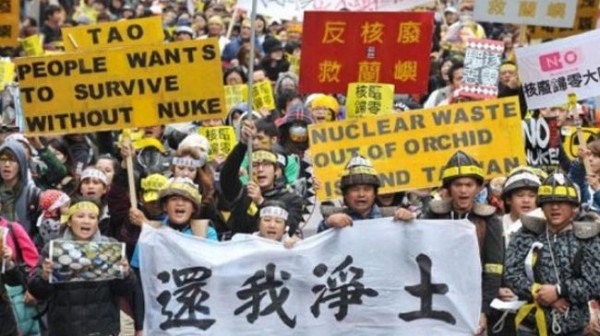On this day, called the Double Tenth*, and the founding day of modern Taiwan, many Taiwanese are pleading that the government closes in on the nuclear power industry and begins a countdown on nuclear plants, closing for good. The retirement of existing nuclear reactors was a significant issue in the 2012 presidential election.
This past August, groups protested in Taipei and there were scuffles among lawmakers, over a proposed nuclear vote. This followed a much bigger anti-nuclear protest with 220,000 on the street on March 9, this year. The issue was Taiwan’s fourth nuclear power plant and the activists were urging the government to immediately stop work on the almost-completed project.
Members of the Taiwan Anti-Nuclear Action League showed placards and shouted slogans to express that the project to be scrapped.
The League is made up mostly of members from the anti-nuclear organizations, such as the Taiwan Environmental Protection Union, the Humanistic Education Foundation, and the Green Citizens’ Action Alliance.
The plant is situated in a coastal area of densely-populated New Taipei City. The scuffles took place as ruling Kuomintang (KMT) lawmakers held a showdown with the main opposition, the Democratic Progressive Party (DPP), over a proposed referendum on the nuclear plant.
The DPP insisted that the project should be scrapped without the referendum, which it criticizes for having too high a threshold to ever yield a “yes” answer or to even become valid – a valid point as Taiwan has put six national referendum questions to voters since the Referendum Act came into effect in January 2004, all have fallen short of the 50 percent participation threshold.
Following the continuing massive problems at Japan’s Fukushima and the fact that Taiwan is highly active with earthquakes, these factors alone should cause the Taiwanese to reflect very deeply before continuing with any nuclear power generation facility, especially being an island!
The launch into nuclear power generation is especially difficult to understand given that Taiwan has easy access to geothermal energy. Taiwan did build such a plant in the 1980s. This was closed in the 1990s as output declined and the price of oil decreased internationally.
As an example of what can be done using geothermal power the USA which is the biggest producer and user, is destined to have a total geothermal power output of 20,000 MW by 2020 – the nuclear plant under protest in Taiwan would generate only 2,700 MW if made operational. There are 29 geothermal plants in the USA and when it comes to energy supply distributed, small scale operations are safer than any big centralised plant.
The Philippines is the next biggest producer of thermal energy, supplying 13 percent of the country’s energy needs – and that country backed off from building a nuclear power plant, of Westinghouse design, many years ago.
Far away over in Iceland, geothermal power generation made up half the country’s electricity by the year 2006!
Deep geothermal energy has been recognised as holding great potential for Taiwan as its terrain is superior to most other places for this advanced method of energy extraction (as against shallow geothermal energy).
A report titled: “National Science and Energy Program – Energy” by the National Science Council (Taiwan) states that, including secondary sources, as much as 25,000 MW of power – nearly ten times that of the disputed power plant number 4, could be generated if the island went with geothermal – and could cease all nuclear power generation activities.
As with every nuclear power plant contaminated waste storage is a problem thus far without solution. In Taiwan all the radioactive waste is shipped to Orchid Island. The media has reported on other recent protests where scores of aboriginal protesters, “demanded the removal of 100,000 barrels of nuclear waste stored on their Orchid Island, off south-eastern Taiwan.”
Authorities have failed to find a substitute storage site in part because of increased public awareness of the dangers of stored radioactive waste that has to be kept cool, continuously, or else!
The nuclear power issue continues to be contentious in Taiwan.
*
The national day of the Republic of China (ROC) commemorates the start of the Wuchang Uprising of October 10, 1911, which led to the collapse of the Qing Dynasty in China and establishment of the Republic of China on January 1, 1912.
On mainland China, it is celebrated as the anniversary of the Xinhai Revolution and the Wuchang Uprising.
Double Ten Day Celebration in Hong Kong.
Before the sovereignty of Hong Kong was transferred to the PRC in 1997, many ROC supporters in the territory would display patriotic flags (mainly the national flag of ROC). The day continues to be celebrated in Hong Kong after the transfer of sovereignty to the mainland, but the national flags publicly shown have been removed by Police of Hong Kong ever since July 1997. Though, in street demonstrations it is increasingly notable that the Taiwan flag is making appearances. It can be assumed that the police are ‘just letting it go’ instead of creating further disturbances but it is illegal.










